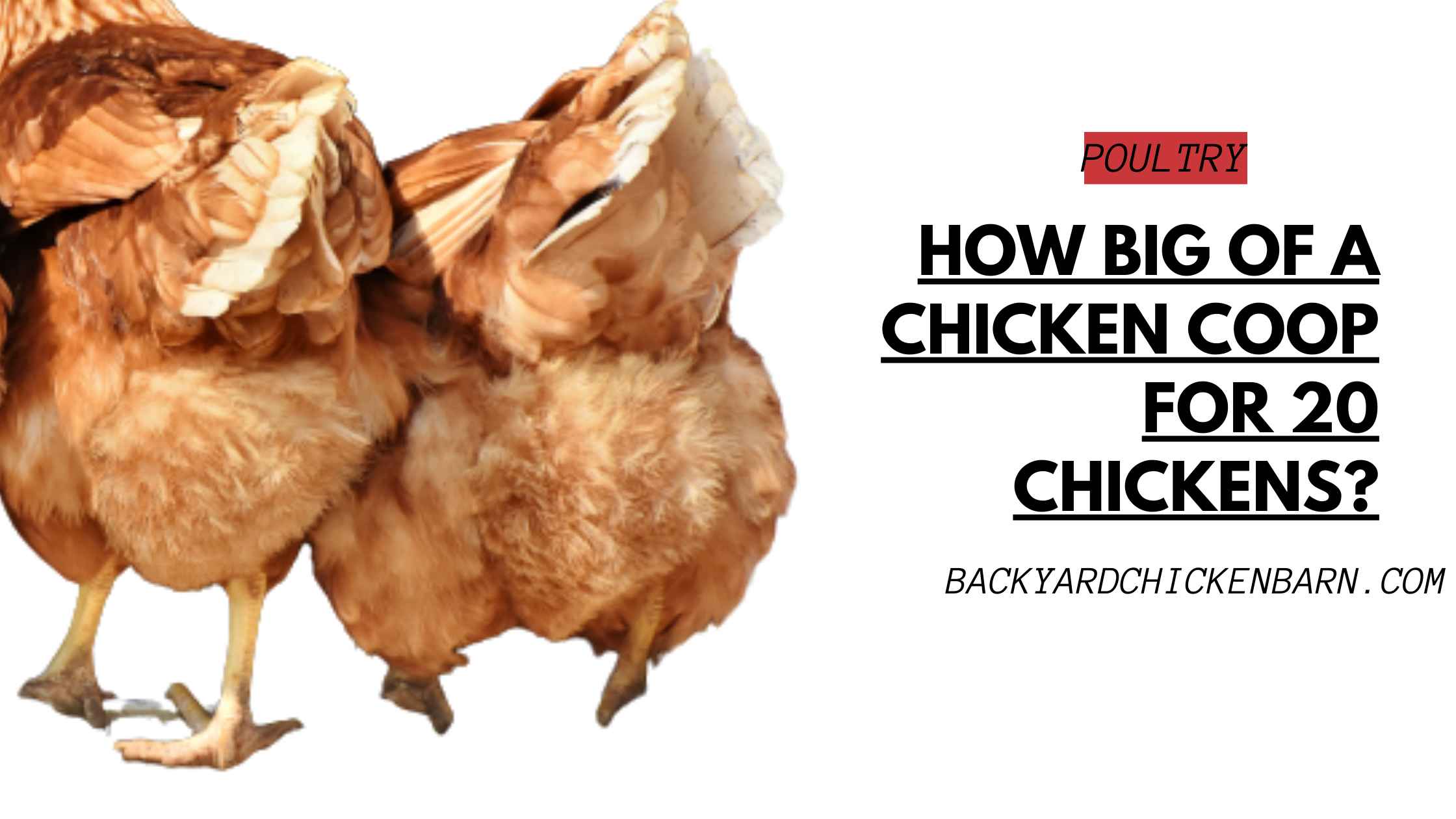How Big of a Chicken Coop for 20 Chickens?
It was a bright, sunlit morning when I sat down with a coffee in hand, mapping out my plans for expanding my little brood of hens.
The ambition was clear: I wanted a flock of 20. But a lingering question had me sketching, erasing, and re-sketching: How big should the coop be to comfortably house them? After much research, consultation, and firsthand experience, I’ve learned that size indeed does matter when it comes to poultry homes.
To cut to the chase: For 20 chickens, you’ll ideally need a coop that offers at least 60-80 square feet of space. This ensures each chicken has a minimum of 3-4 square feet to themselves, allowing room for roosting, laying, and general movement.
Now, while the above gives you a straightforward answer, it’s worth diving deeper into the specifics, nuances, and my experiences, which might resonate with any budding poultry enthusiast:
1. Consider Chicken Breeds:
I began with a mix of Bantams and larger breeds. It’s essential to know that Bantams require slightly less space than their bigger counterparts.
Tailor your coop size based on the specific breeds you’re keeping.
2. Space Beyond Square Footage:
When I started planning, I mistakenly equated space with square footage. However, vertical space is equally crucial.
Ensure there’s enough height for perches, nesting boxes, and general headroom.
3. Movement & Behavior:
Chickens are sociable creatures. They need space to interact, play, and sometimes, escape a pecking neighbor.
A coop that’s too cramped can lead to stress, disease, and even aggressive behavior.
4. Cleaning & Maintenance:
The larger the coop, the more challenging it might be to clean. However, I found that a well-designed, adequately spaced coop is easier to maintain than a cramped one.
Proper space allows for better ventilation, reducing moisture and associated diseases.
5. Nesting Needs:
For my 20 chickens, I ensured there were at least 4-5 nesting boxes. Each box needs about 1 square foot. Having multiple boxes reduces territorial disputes during laying times.
6. Outdoor Access:
It’s not just about the coop. Access to an outdoor run can supplement space needs. I attached a run that provided an additional 10 square feet per chicken, ensuring they could stretch, forage, and dust-bathe.
7. Future Plans:
When I started, 20 was the magic number. But poultry-keeping can be addictive! Always plan for potential expansion. It’s easier to build bigger initially than to retrofit later.
8. Natural Elements:
Remember to account for windows, vents, and perhaps a skylight. These not only aid in ventilation and light but can also consume space. Incorporate them without compromising on the essential square footage.
In conclusion, while the guideline of 3-4 square feet per chicken is a good starting point, personal observations and understanding of your flock’s needs will guide the final design.
Through my journey, I’ve learned that a happy chicken is a productive one. And happiness, often, starts with a spacious, comfortable coop.
So, grab those blueprints, factor in these insights, and embark on building a dream home for your feathery friends!
ALSO SEE: Do Chicken Coops Need Windows?

FAQs on Coop Size for 20 Chickens
1. How much space is needed for 20 chickens in a coop? You’ll need 60-80 square feet of space, ensuring each chicken has 3-4 square feet for themselves.
2. Does the chicken breed impact coop size? Yes. Bantams, being smaller, require less space than larger breeds.
3. What’s the significance of vertical space in a coop? Vertical space is crucial for perches, nesting boxes, and ensuring chickens don’t feel cramped overhead.
4. How can cramped coops affect chicken behavior? Insufficient space can lead to stress, aggressive behavior, and a higher risk of disease.
5. How many nesting boxes should a coop for 20 chickens have? Ideally, 4-5 nesting boxes, as each requires about 1 square foot.
6. How does a larger coop influence cleaning and maintenance? While a bigger coop might seem more challenging to clean, proper space can improve ventilation and reduce disease, making maintenance easier.
7. Should I consider an outdoor run in addition to the coop? Yes, an outdoor run can provide additional space for chickens to forage, stretch, and dust-bathe.
8. How much space should an outdoor run offer per chicken? At least 10 square feet per chicken is recommended.
9. Are there any coop features that can take up internal space? Yes, elements like windows, vents, and skylights can consume space but are essential for light and ventilation.
10. How does coop size affect chicken happiness and productivity? A spacious, comfortable coop ensures happy chickens, which tend to be more productive in laying eggs.
11. Is the 3-4 square feet per chicken a fixed rule? It’s a guideline. Personal observations and understanding of your flock’s needs will guide the final design.
12. What happens if chickens don’t have enough space? They can become stressed, exhibit aggressive behavior, and might suffer from health issues.
13. How does coop size affect ventilation? Adequate space allows for better airflow, ensuring a healthier environment inside the coop.
14. Can I expand the coop later if I get more chickens? While possible, it’s easier and more cost-effective to plan for potential expansion from the outset.
15. Should I factor in growth when choosing coop size? Yes, always account for potential future additions to your flock.
16. How high should the ceilings of the coop be? Ensure enough height for perches, nesting boxes, and general headroom for the chickens.
17. Can a coop be too big for 20 chickens? While spaciousness is good, an excessively large coop might be harder to maintain and heat during colder months.
18. Do roosters require additional space in the coop? Roosters are generally larger and might appreciate a bit more space, but the 3-4 square foot guideline is still a good starting point.
19. Are there design elements to make cleaning easier in a large coop? Consider removable trays, easily accessible doors, and good flooring to facilitate cleaning.
20. Should the coop be situated in a specific direction for light? Ideally, orient your coop to maximize natural light, which can boost egg production.
21. How do windows contribute to a coop’s size? Windows offer ventilation and light without compromising much on space. However, they should be integrated without reducing the essential square footage.
22. Do chickens need personal space? Like humans, chickens appreciate personal space, especially when roosting and laying.
23. Can chickens share nesting boxes? Yes, chickens often take turns using nesting boxes. Hence, 4-5 boxes can suffice for 20 chickens.
24. How can I maximize space in my chicken coop? Efficient design, multi-level perches, and well-placed nesting boxes can help utilize space effectively.
25. Does the coop’s exterior size correlate with its interior space? Not always. Thick walls or added insulation can reduce interior space. Always measure the interior.
26. Do all 20 chickens need to be in the coop at once? Not necessarily, but the coop should accommodate all birds comfortably when they choose to be inside, especially at night.
27. How can I ensure my coop is not overcrowded? Regularly observe your chickens’ behavior. Signs of stress, aggression, or illness can indicate a lack of space.
28. Should I consider mobile or stationary coops for 20 chickens? Both can work, but mobile coops, or “chicken tractors,” offer the advantage of fresh ground regularly.
29. Can coop space affect egg-laying frequency? Yes. Stressed or uncomfortable chickens may lay fewer eggs or exhibit inconsistent laying patterns.
30. How important is an outdoor run compared to the coop’s size? While the coop provides shelter and safety, an outdoor run offers additional space for natural behaviors, complementing the coop’s size.
31. Do chicks require the same amount of space as mature chickens? Chicks need less space initially but quickly grow, so it’s essential to plan for their adult size.
32. Are there any dangers of an overly spacious coop? Too much space can make it challenging to maintain a consistent temperature in colder climates.
33. How does coop size relate to feed and water placement? A larger coop allows for more flexibility in placing feeders and waterers, ensuring all chickens have access.
34. What flooring is best for a large coop? Durable, easy-to-clean materials like linoleum or deep-litter methods with straw can be effective.
35. How can coop size prevent or exacerbate pests? An adequately sized and well-maintained coop reduces moisture and waste buildup, deterring pests.
36. Should I consider coop size in relation to my yard’s size? Yes. Ensure the coop size is proportionate to your available outdoor space.
37. Can I divide a large coop into sections for different poultry types? Yes, dividers can be useful, especially if keeping ducks or other fowl with chickens.
38. Does coop size affect the need for heating or cooling mechanisms? A larger coop may require more effort to heat. Proper ventilation can assist with cooling in warmer months.
39. Is there a ratio of coop space to outdoor run space? While the exact ratio can vary, providing at least 10 square feet of run space per chicken in addition to coop space is recommended.
40. Should I seek professional advice when determining coop size? While personal research is invaluable, consulting with seasoned poultry keepers or professionals can offer tailored insights for your specific needs.



